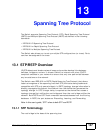
Chapter 13 Spanning Tree Protocol
XGS-4526/4528F/4728F User’s Guide
150
Note: Each port can belong to one STP tree only.
13.1.5 Multiple STP
Multiple Spanning Tree Protocol (IEEE 802.1s) is backwards compatible with STP/
RSTP and addresses the limitations of existing spanning tree protocols (STP and
RSTP) in networks to include the following features:
• One Common and Internal Spanning Tree (CIST) that represents the entire
network’s connectivity.
• Grouping of multiple bridges (or switching devices) into regions that appear as
one single bridge on the network.
• A VLAN can be mapped to a specific Multiple Spanning Tree Instance (MSTI).
MSTI allows multiple VLANs to use the same spanning tree.
• Load-balancing is possible as traffic from different VLANs can use distinct paths
in a region.
13.1.5.1 MSTP Network Example
The following figure shows a network example where two VLANs are configured on
the two switches. If the switches are using STP or RSTP, the link for VLAN 2 will be
blocked as STP and RSTP allow only one link in the network and block the
redundant link.
Figure 57 STP/RSTP Network Example
A
B
VLAN 1
VLAN 2


















